Dependence of the silicon carbide radiation resistance on the irradiation temperature
- 作者: Lebedev A.A.1, Kozlovski V.V.2, Levinshtein M.E.1, Davydovskaya K.S.1, Kuzmin R.A.1
-
隶属关系:
- Ioffe Institute RAS
- Peter the Great St. Petersburg Polytechnic University
- 期: 编号 9 (2024)
- 页面: 58-63
- 栏目: Articles
- URL: https://freezetech.ru/1028-0960/article/view/664748
- DOI: https://doi.org/10.31857/S1028096024090072
- EDN: https://elibrary.ru/EHUGXL
- ID: 664748
如何引用文章
详细
The effect of high-temperature electron and proton irradiation on the characteristics of devices based on SiC has been studied. For the study, industrial 4H-SiC integrated Schottky diodes with an n-type base with a blocking voltage of 600, 1200 and 1700 V manufactured by CREE were used. Irradiation was carried out by electrons with an energy of 0.9 MeV and protons with an energy of 15 MeV. It was found that the radiation resistance of SiC Schottky diodes under high-temperature irradiation significantly exceeds the resistance of diodes under irradiation at room temperature. It is shown that this effect arises due to the annealing of compensating radiation defects under high-temperature irradiation. It is shown that this effect arises due to the annealing of compensating radiation defects under high-temperature irradiation. The parameters of radiation defects were determined by the method of non-stationary capacitance spectroscopy. Under high-temperature (“hot”) irradiation, the spectrum of radiation-induced defects introduced into SiC differed significantly from the spectrum of defects introduced at room temperature. The radiation resistance of silicon and silicon carbide is compared. The relatively small difference in the rate of removal of carriers in SiC and Si upon irradiation at room temperature is due to the fact that in SiC, in contrast to Si, there is practically no annealing of primary radiation defects during irradiation.
全文:
作者简介
A. Lebedev
Ioffe Institute RAS
编辑信件的主要联系方式.
Email: shura.lebe@mail.ioffe.ru
俄罗斯联邦, St. Petersburg, 194021
V. Kozlovski
Peter the Great St. Petersburg Polytechnic University
Email: vkozlovski@spbstu.ru
俄罗斯联邦, St. Petersburg, 195251
M. Levinshtein
Ioffe Institute RAS
Email: shura.lebe@mail.ioffe.ru
俄罗斯联邦, St. Petersburg, 194021
K. Davydovskaya
Ioffe Institute RAS
Email: shura.lebe@mail.ioffe.ru
俄罗斯联邦, St. Petersburg, 194021
R. Kuzmin
Ioffe Institute RAS
Email: shura.lebe@mail.ioffe.ru
俄罗斯联邦, St. Petersburg, 194021
参考
- Choyke W.J. // Inst. Phys.: Conf. Ser. 1977. V. 31. P. 58.
- Hallen A., Henry A., Pelligrino P., Swensson B.G., Aberg D. // Mater. Sci. Eng. B. 1999. V. 61–62. P. 378.
- Casse G. // J. Instrum. Methods Phys. Res. A. 2009. V. 598. P. 54.
- Metcalfe J., on behalf of the RD50 Collaboration // J. Nucl. Phys. B Proc. Suppl. 2011. V. 215. P. 151. https://www.doi.org/10.1016/j.nuclphysbps. 2011.03.162
- Swensson B.G., Hallen A., Linnarson M.K., Kuznetsov A.Yu., Janson M.S., Aberg D., Osterman J., Persson P.O.A., Hultman L., Storasta L., Carlsson F.H., Bergman J.P., Jagadish C., Morvan E. // Material Science Forum. 2001. V. 353–356. P. 349.
- Лебедев А.А., Козловский В.В. // ФТП. 2014. T. 48. C. 1329.
- Lang D.V. // J. Appl. Phys. 1974. V. 45. P. 3023.
- Kozlovski V.V., Strokan N.B., Ivanov A.M., Lebedev A.A., Emtsev V.V., Oganesyan G.A., Poloskin D.S. // Phys. B. 2009. V. 404. P. 4752.
- Kalinina E.V., Lebedev A.A., Bogdanova E.V., Lebedev A.A., Berenquier B., Ottaviani L., Violina G.N., Skuratov V.A. // Semiconductors. 2015. V. 4. P. 540.
- Hazdra P., Vobecky J. // Phys. Status Solidi. A. 2019. V. 216. P. 1900312. https://doi.org/10.1002/pssa.201900312.
- Castaldini A., Cavallini A., Rigutti L., Nava F. // Appl. Phys. Lett. 2004. V. 85. P. 3780.
- Kaneko H., Kimoto T. // Appl. Phys. Lett. 2011. V. 98. P. 262106. https://doi.org/10.1063/1.3604795
- Hazdra P., Popelka S. // IET Power Electron. 2019. V. 12. P. 3910. https://doi.org/iet-pel.2019.0049
- Vobecky J., Hazdra P., Popelka S., Sharma K.R. // IEEE Trans. Electron Dev. 2015. V. 62. P. 1964. https://doi.org/10.1109/TED.2015.2421503
- Castaldini A., Cavallini A., Rigutti L. // Semicond. Sci. Technol. 2006. V. 21. P. 724. https://doi.org/10.1088/0268-1242/21/6/002
- Bathen M.E., Lew C.T.-K., Woerle J., Dorfer C., Grossner U., Castelletto S., Johnson B.C. // J. Appl. Phys. 2022. V. 131. P. 140903. https://doi.org/10.1063/5.0077299
- Lebedev A.A. Radiation Effects in Silicon Carbide. / Proc. Mater. Res. Forum LLC, Millersville, USA, 2017. V. 6. ISSN 2471-8890; ISBN 978-1-945291-11-1
- Lebedev A.A., Kozlovski V.V., Davydovskaya K.S., Levinshtein M.E. // Materials. 2021. V. 14. P. 4976. https://www.doi.org/10.3390/ma14174976
- Corbett J.W., Bourgoin J.C. Defect Creation in Semiconductors // Point Defects in Solids, V. 2. Semiconductors and Molecular Crystals. / Ed. Crawford J.H., Slifkin L.M. New York, London: Plenum Press, 1975. P. 1.
- Claeys C., Simoen E. Radiation Effects in Advanced Semiconductor Materials and Devices. Berlin: Springer–Verlag, 2002. 401 p.
- Lindstrom J.L., Murin L.I., Hallberg T., Markevich V.P., Svensson B.G., Kleverman M., Hermansson J. // Nucl. Instrum. Methods Phys. Res. B. 2002. V. 186. Iss. 1–4. P. 121.
补充文件















